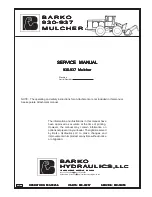
PRE-DELIVERY CHECKS
Form 169018
40
Revision C
STEP 13. PERFORM PRE-
DELIVERY CHECKS
WARNING
Stop windrower engine and remove key before
making adjustments to machine. A child or
even a pet could engage the drive.
a. Perform the final checks and adjustments as listed
on the "Pre-Delivery Checklist" (yellow sheet) to
ensure the machine is field-ready. Refer to the
following pages for detailed instructions as
indicated on the checklist.
b. The completed checklist should be retained either
by the Operator or the Dealer.
A. FINAL DRIVE LUBRICANT LEVEL
a. Rotate wheel so that one of the plugs is
horizontally aligned with the center of the hub.
b. Remove the plug. The oil should be visible
through the hole or slightly running out.
B. TIRE PRESSURES AND BALLAST
REQUIREMENTS
I. TIRE
PRESSURES
Measure tire pressure with a gauge.
o
Bar - 32 psi (221 kPa)
o
Turf - 20 psi (138 kPa)
o
Caster - 10 psi (69 kPa)
II. BALLAST
REQUIREMENTS
Fluid ballasting of rear caster tires is
recommended to provide adequate machine
stability when using large headers on the
windrower.
Also, the stability of machine varies with different
attachments, windrower options, terrain and
Operator’s driving technique.
Ballast capability per tire is at a maximum fill of
75%, or when fluid is level with valve stem when
the stem is positioned at the “12 o’clock” position.
Fluid can be added to any level up to maximum
fill, and always add an equal amount of fluid on
both sides.
TIRE SIZE
FLUID PER TIRE
AT 75% FILL
U.S. Gal. (Liters)
TOTAL WEIGHT
OF BOTH TIRES
lb (kg) *
7.5X16
(A)
10 (38)
200 (91)
10X16
(B)
18 (69)
380 (170)
16.5X16.1
(C)
41 (158)
830 (377)
* Weights are given for typical calcium chloride
and water mixtures. Weight is reduced by 20% if
only water is used (for areas that do not require
anti-freeze protection).
(continued next page)
OIL LEVEL
OIL LEVEL
WHEEL CONFIGURATION B
WHEEL CONFIGURATION A














































